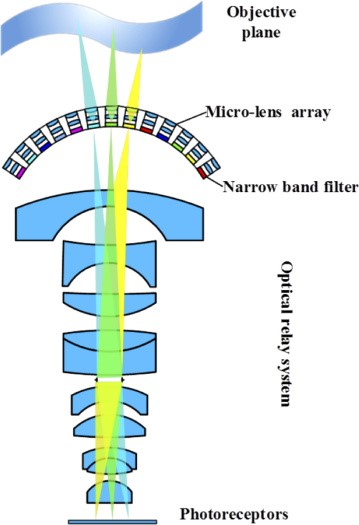Multispectral imaging technology has found wide applications in remote sensing for it has a relatively high spectral resolution.
But the existing technologies have many shortcomings such as low system integration, high complexity, small field of view (FOV), and are not suitable for real time spectral imaging applications on airborne or satellite borne.
How to solve this bottleneck? Nature is the best teacher of mankind.
A research team led by Prof. Dr. YU Weixing from Xi'an Institute of Optics and Precision Mechanics (XIOPM) of the Chinese Academy of Sciences (CAS) proposed the multispectral curved compound eye camera (MCCEC) based on bionic compound eye camera system, which can simultaneously obtain information of multiple spectrum segments on 7 narrow wavebands at real time in an ultra large FOV of up to 120°. This work was published in the journal Optics Express.
 The cross-sectional schematic of the MCCEC. (Image by XIOPM)
The cross-sectional schematic of the MCCEC. (Image by XIOPM)
Actually, the MCCEC consists of three subsystems, a curved micro-lens array integrated with selected narrow-band optical filters, an optical transformation subsystem, and the data processing unit with an image sensor.
Also, it has a good imaging quality with a cutoff spatial frequency largerthan 100lp/mm. Furthermore, the tolerance analysis indicates that the designed MCCEC has a reasonable diffraction MTF out of the manufacturing and assembling tolerances. The formed MCCEC consists of about 117 microlenses and 7 spectral channels.
All in all, the designed MCCEC has huge advantages over traditional multispectral cameras systems, and it can be further adapted or optimized to be airborne or satellite borne payloads for remote sensing for multispectral imaging in real time with an ultra large FOV.


